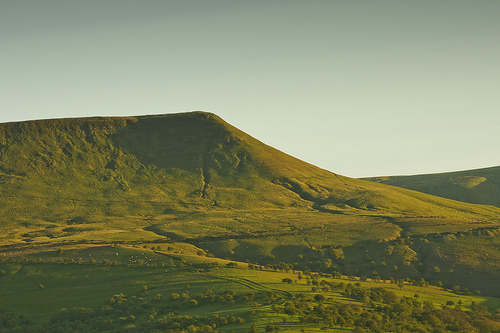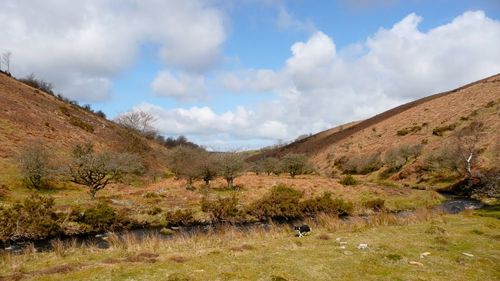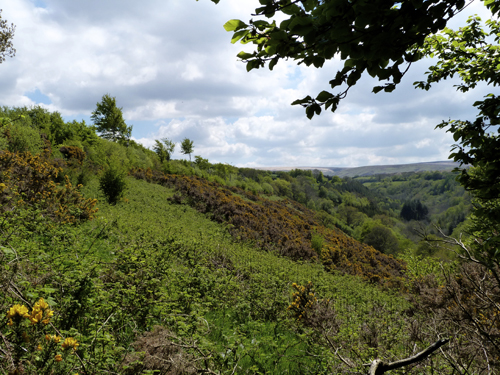by Ginny Battson, researcher in environmental ethics and sustainability
Hay Bluff – set for rewilding?
Elephants on the Epynt? I can almost hear disbelief in the voices of my ancestors who farmed the Mid Walian uplands for generations.
But yes. Author, columnist and self proclaimed ‘professional trouble maker ‘ George Monbiot is passionately keen to see elephants, and many other extirpated ungulate and predator species, wandering our hills again. His book, ‘Feral‘ is soon to be set loose upon us like a wolf among sheep and I’ll be going to my local, and threatened, library to borrow it.
Already thrilled by an encounter with a fox near Filton railway station, so rare is it that I see them in the ‘wild’, I arrived at the beautiful venue of St George’s Bristol looking forward to learning more on this idea of ‘rewilding’ at the Festival of Ideas. To my surprise, Monbiot began by speaking of hedge laying.
He posed a question: How is it that our native hedgerow tree species spring back from within an inch of their life after being subjected to a brutal thrashing (you might say, art), by traditional hedge layers? “Elephants!” he exclaimed. Elephants of an ancient Britain would have mauled, chewed and trampled these species, which in turn would have adapted to the disturbance by evolving to vigorously regenerate. Hedge layers and coppicers simply mimic these hunted-out megafauna. It seems we live among the battered remnants of a ghost-ecosystem where the key engineers, such as elephants, have all but vanished.
On a recent sunny day, I walked with my young daughter beneath a row of veteran holly, which towered in glory above our path . I asked her, “why do you think the lower leaves are so prickly and the ones on the top of the tree have no spines at all ?” “Goats?”, she wistfully suggested. Nearly! For there is evidence to suggest spiny leaves, technically called the spinescence, of some of our most popular native trees have evolved since the interglacial period (114,000-130,000 years ago) to withstand the marauding, hungry mouths of larger ungulates like moose. And where there are large ungulates there are predators. Paleoecology suggests many native tree species we hold dear in the UK today have evolved from ecosystems dominated by such interactions: other animals include rhinoceros, bears, hyenas, wolves, lynx, lions, beavers and boar.
So what would happen if we were to reintroduce some of those key ecosystem engineers here in the UK? We have, of course, a little foreknowledge with the introductions of boar and beaver. But the really interesting part of the rewilding concept… perhaps we might recreate a biodiversity boom. Monbiot went on to embellish. The study of Trophic Cascades has added a renewed vigour to the science of ecology, highlighting powerful indirect interactions that can control entire ecosystems, top down, all the way to nutrient cycles. Remote valleys and mountains around the world which have miraculously escaped human intervention support the theory, a plethora of life ‘cascading’ down from the existence of megafauna.
There’s a growing movement of Europeans who would back Monbiot. Calls for rewilding by advocates for nature are hailing from many parts of the globe. Britain as a member of the EU has one of the most intensely cultivated landscapes in Europe. Forest coverage is pretty low here though has increased from 5% at the beginning of the 20th Century to around 11% today. He believes the CAP system of farming subsidy has not been generally helpful to the environment, is unsustainable and will one day evaporate. So we need new perspectives on landscape, particularly in upland areas, and what better way than to rewild.
Monbiot studied zoology at Oxford and went on to an early career in the BBC’s Natural History Unit producing radio. He’s passionate about nature and natural encounters, and relished describing breaching cetaceans off the coast of Wales whilst sea kayaking. The sea is perhaps an obvious target area for rewilding. Marine Conservation no-take zones could be extended far beyond the currently proposed networks, though even these are proving to be a legislative struggle.
Back to terra firma. Sadly, Monbiot doesn’t like sheep. Now personally, I LOVE the Ovis aries, but of course I am Welsh! I know their rangy over-grazing on uplands has caused huge changes to the ecosystems that were once dominant. And yet there are many who would fight to retain these changes. Not Monbiot. Upland trees are cleared, gorse and heather survive only to be burned off for ‘improvement’ or shoots, natural succession stymied by the constant nibbling of short stems by the droves of white clouds with legs. The after-effects look not dissimilar to Amazonian deforestation. Yet many small-scale hill farmers struggle to live above the poverty line. Without subsidy, he asserts, there would be no point.
There may be other reasons to target the restoration of uplands; changing climate means sequestering carbon and rainwater storage would be good use of the land, whilst increased native forest cover could provide ‘ecosystem service’ water purification. Many would increasingly agree. And quite a few of us would like to see the end of shooting, though an argument for another day. I’m not totally convinced in SSSI designation, or indeed any wildlife reserve, as an absolute cure for upland degradation, a precious and joyous sticking plaster, but stats on SSSI’s nationally report overgrazing is the main cause of degradation particularly in Mid Wales and Scotland. Undergrazing might not fit the bill of conventional conservation either but if there’s an opportunity for self-willed land, then I’m for it, despite potential infringements on my liberty. However, an integrated approach cannot be ignored and true nature-friendly farmers such as Beck Hosking and Tim Green at Wolf Tree Farm may well be able to transform a Welsh hilltop sheep farm into a thriving agroecological business.
So the down sides? Concerned citizens of the Earth struggle with the sad reality of environmental degradation, although nature in its indomitable way is adapting to our impacts all the time. What nature struggles with most, however, is the high speed of change. Rewilding might even occur too quickly for the rest of nature to adapt, including some humans and their communities who live the land. And isn’t it just another high-handed act upon the environment? Interventionism is a hard habit to break. We can’t rewild simply because we might find it exciting, can we? As I’ve already suggested, an equally interesting idea might simply be to abandon land and see what else occurs beyond a short-term loss of biodiversity. Natural succession is a beautiful thing for nature’s sake not only our own. But of course, we are constantly told by politicians and economists that nature must directly do more for us, not less. The idea of ‘abandonment’ might over stretch the patience of food producers and active conservationists alike. Further, I predict wildlife/human conflict resolution being a hot area in University funding and there will be welfare and hunting issues. Many of them. And with certainty, calls for culls from obvious quarters once populations begin to establish in any significant number.
Maybe as we are integral to nature, our intervention is inevitable, even in our choosing to be passive. And stories of those mystical Baskerville Hounds and Bodmin Panthers do seem to light a relic flame in our hearts. Perhaps to dream of dripping epiphytic temperate rain forests, savanna grasslands, mighty free ranging rivers and crystal mountain peaks? Michael P Branch, Professor of Literature and Environmental Studies suggests..
“…the first step in rewilding must be to introduce the possibility of the marvelous to our imagination of the land.”
I think George Monbiot did that……though there will be many critical ‘pragmatists’. Elephants on the Epynt…..?
______
Addendum: Questions from the audience were also interesting. Is it all a hopeless dream? Doesn’t this conflict with UK food security? Aren’t we allying with the proponents of intensification who argue for land sparing not sharing? Perhaps too simply, Monbiot suggested we should all eat a lot less lamb.
Later, after the event, I joined some friends to discuss the talk over dinner. I had humus but with little hesitation the evolutionary biologist in the party ordered….yes! Lamb.































A wonderful read and in truth I would rather continue reading a book along these lines than the book in question.
Of course as a practitioner I struggle immensely with ‘rewilding’. Natural regeneration of course if the soils are right, but the fact that Britain is a virtually complete human landscape is something that should be celebrated, researched and used as a case study of establishing sustainable land management techniques for the rest of world to use. Instead land management is stuck in the doldrums, from which many including Monbiot profit from – continuing a polarisation we can ill afford.
Now if there was a book which looked at the land management techniques throughout the millennia of human intervention before the industrial revolution – that would be worth reading.